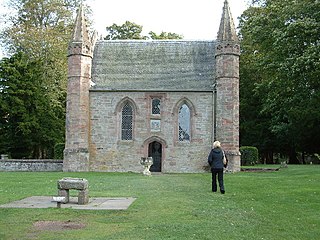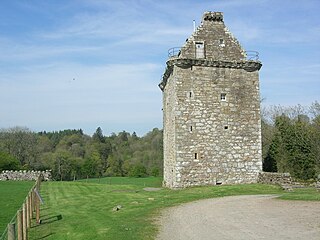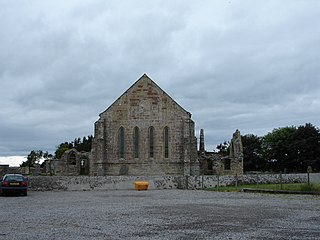See also
Senior churchmen of Medieval Scotland (post-1100) | |
|---|---|
| Archbishops | |
| Bishops | |
| Archdeacons | |
| Abbots | |
| Priors | |
| | This article related to religion in Scotland is a stub. You can help Wikipedia by expanding it. |
The Prior of Canonbie was the head of the Augustinian monastic community of Canonbie Priory, in Dumfries and Galloway. The priors are badly documented and few are known. The following is a list of priors who are known:

Wenlock Priory, or St Milburga's Priory, is a ruined 12th-century monastery, located in Much Wenlock, Shropshire, at grid reference SJ625001. Roger de Montgomery re-founded the Priory as a Cluniac house between 1079 and 1082, on the site of an earlier 7th-century monastery. In 1101 bones, believed to be those of Saint Milburga, were discovered beneath the floor of the old church. The relics were ceremoniously translated to the main monastery church.

Inchmahome Priory is situated on Inchmahome, the largest of three islands in the centre of the Lake of Menteith, close to Aberfoyle, Scotland.
The Abbot of Paisley was the head of the Cluniac monastic community of Paisley Abbey and its property. The monastery was founded as a priory at Renfrew in 1163, but moved to Paisley in 1169. It became an abbey in 1219. The founder was Walter fitz Alan, Seneschal (Steward) of Scotland. The line of abbots ended when it was turned into a secular lordship for Lord Claud Hamilton in 1587/1592. The following is a list of abbots and commendators:

Scone Abbey was a house of Augustinian canons located in Scone, Perthshire (Gowrie), Scotland. Dates given for the establishment of Scone Priory have ranged from 1114 A.D. to 1122 A.D. However, historians have long believed that Scone was before that time the center of the early medieval Christian cult of the Culdees. Very little is known about the Culdees but it is thought that a cult may have been worshiping at Scone from as early as 700 A.D. Archaeological surveys taken in 2007 suggest that Scone was a site of real significance even prior to 841 A.D., when Kenneth MacAlpin brought the Stone of Destiny, Scotland's most prized relic and coronation stone, to Scone.

Gilnockie Tower is a 16th-century tower house, located at the hamlet of Hollows, 2.3 km north of Canonbie, in Dumfries and Galloway, south-west Scotland. The tower is situated on the west bank of the River Esk. It was originally known as Hollows Tower.
The Prior of St Andrews was the head of the property and community of Augustinian canons of St Andrews Cathedral Priory, St Andrews, Fife, Scotland. It was established by King David I in 1140 with canons from Nostell Priory, West Yorkshire. It is possible that, initially at least, the prior of St Andrews was subordinate to the bishop as abbot, but by the 13th century the canons of St Andrews were given freedom by the bishop to elect their prior. By the end of the 13th century, the abbacy of the native canons was no longer there to challenge the position of the priory, and the native canons themselves had been formed into a collegiate church.
The Prior of Loch Leven was the head of lands and of the community Augustinian canons of St Serf's Inch Priory, Loch Leven. There was a Scottish Céli Dé establishment there in the first half of the 12th century, allegedly found by Bruide, son of Dargart, King of the Picts (696–706). When the Augustinian priory was founded in 1150, the Scottish monks were absorbed into the established and those who refused to join were to be expelled. Not all of the priors are known. The most famous prior undoubtedly was the chronicler, Andrew de Wyntoun. Following more than four centuries of Augustinian monastic life and the resignation of the last prior, the Protestant king, James VI of Scotland, granted the priory to St Leonard's College, St Andrews.
The Prior of Inchmahome was the head of the community of Augustinian canons at Inchmahome Priory, on Inchmahome in the Lake of Menteith, in Highland Stirlingshire, Scotland. The following is a list of priors and commendators:
The Prior of Oronsay was the Religious Superior of Oronsay Priory, a community of canons regular on the island of Oronsay, Inner Hebrides, off the coast of Scotland. It was in existence by 1353, perhaps founded by John of Islay, Lord of the Isles.

The Abbot of Fearn was the head of the Premonstratensian monastic community of Fearn Abbey, Easter Ross, Scotland. The Abbey was founded by canons from Whithorn Priory in Galloway, with the patronage of Fearchar mac an t-Sagairt, mormaer/earl of Ross. The foundation took place in the 1220s, according to the two distinct foundation dates given in the sources, either in 1221 or in 1227. Until about 1238, the Abbey was located at Fearn, near Edderton, but it was moved to the Tarbat parish in that year and known thereafter as "nova Furnia". Despite the fact that the head of Whithorn Priory was a prior and Fearn an abbot, Fearn seems to have remained subordinate to Whithorn until at least the end of the 14th century, and even in 1440 Abbot Fionnlagh II was confirmed by the prior of Whithorn.The reason for this is that Whithorn was a cathedral priory; the nominal head of its community was the bishop, but its actual head was the prior, as was the common use in England at places like Durham and Carlisle, but this was not usual in Scotland. In these circumstances the cathedral prior had the same rights as an ordinary abbot.
The Canonbie Priory was a community of Augustinian canons based at Canonbie in Dumfriesshire, Scotland. It was founded from Jedburgh Abbey after a grant by a minor landlord, Turgis de Rosdale, confirmed by of King William somewhere between 1165 and 1170. The house was small and is badly recorded. It was turned into a secular lordship in 1606, as part of Jedburgh Abbey, for Alexander, Lord Home.
The Prior of Strath Fillan was the head of the Augustinian monastic community of Strathfillan Priory, Strath Fillan in Argyll. The priors are badly documented and few are known.
The Prior of Urquhart was the head of the Benedictine monastic community of Urquhart Priory in Moray. The Priory of Urquhart was merged with the Priory of Pluscarden in 1454. The following is a list of priors and commendators: ___NOTOC___
Prior of Monymusk was the head of the property and community of Augustinian canons of Monymusk Priory, Aberdeenshire. The following is a list of priors and commendators:
The Prior of Blantyre was the head of the medieval community of Augustinian canons based at Blantyre Priory. It was founded between 1239 and 1248, but the first prior is not known by name until 1296. Few of the priors are known thereafter until records become more extensive in the 16th century. The following is a list of known priors and commendators:
The Prior of May then Prior of Pittenweem was the religious superior of the Benedictine monks of Isle of May Priory, which later moved to the mainland became called Pittenweem Priory. The priory was originally based on the Isle of May, but was moved by 1318 to its nearby mainland site of Pittenweem, Fife, passing from the overlordship of Reading Abbey (Benedictine) to St Andrews Cathedral Priory (Augustinian). The following is a list of priors and commendators:
The Prior of Coldingham was the head of the Benedictine monastic community of Coldingham Priory in Berwickshire. Coldingham Priory was founded in the reign of David I of Scotland, although his older brother and predecessor King Edgar of Scotland had granted the land of Coldingham to the Church of Durham in 1098, and a church was constructed by him and presented in 1100 AD. The first prior is on record by the year 1147, although an earlier foundation is almost certain. The monastic cell was a dependent of Durham until the 1370s, and in 1378 King Robert II of Scotland expelled the Durham monks; for the following century the cell had two priors, one chosen by Durham and one chosen by the Scots. It became a dependent of Dunfermline Abbey. It was subject to increasingly secular control from the late 15th century into the 16th century. The following is a list of priors and commendators:
John Woodman [Wodman] was a 15th-century churchman based in the Kingdom of Scotland. Woodman was a canon of the diocese of St Andrews, and as such was locally made Prior of Pittenweem on the death of the previous prior, James Kennedy, Bishop of St Andrews; however, he was opposed by one Walter Monypenny, while the new bishop, Patrick Graham, desired the position for himself. Woodman had lost litigation for this post to Monypenny by 17 September 1466, and possession to the bishop, though Woodman was still claiming this priory as late as 1477 when he became Bishop of Ross.

Durham Priory was a Benedictine priory associated with Durham Cathedral, in Durham in the north-east of England. Its head was the Prior of Durham. It was founded in 1083 as a Roman Catholic monastery, but after Dissolution of the Monasteries in 1540 the priory was dissolved and the cathedral was taken over by the Church of England.
Robert of Bridlington was an English clergyman and theologian.